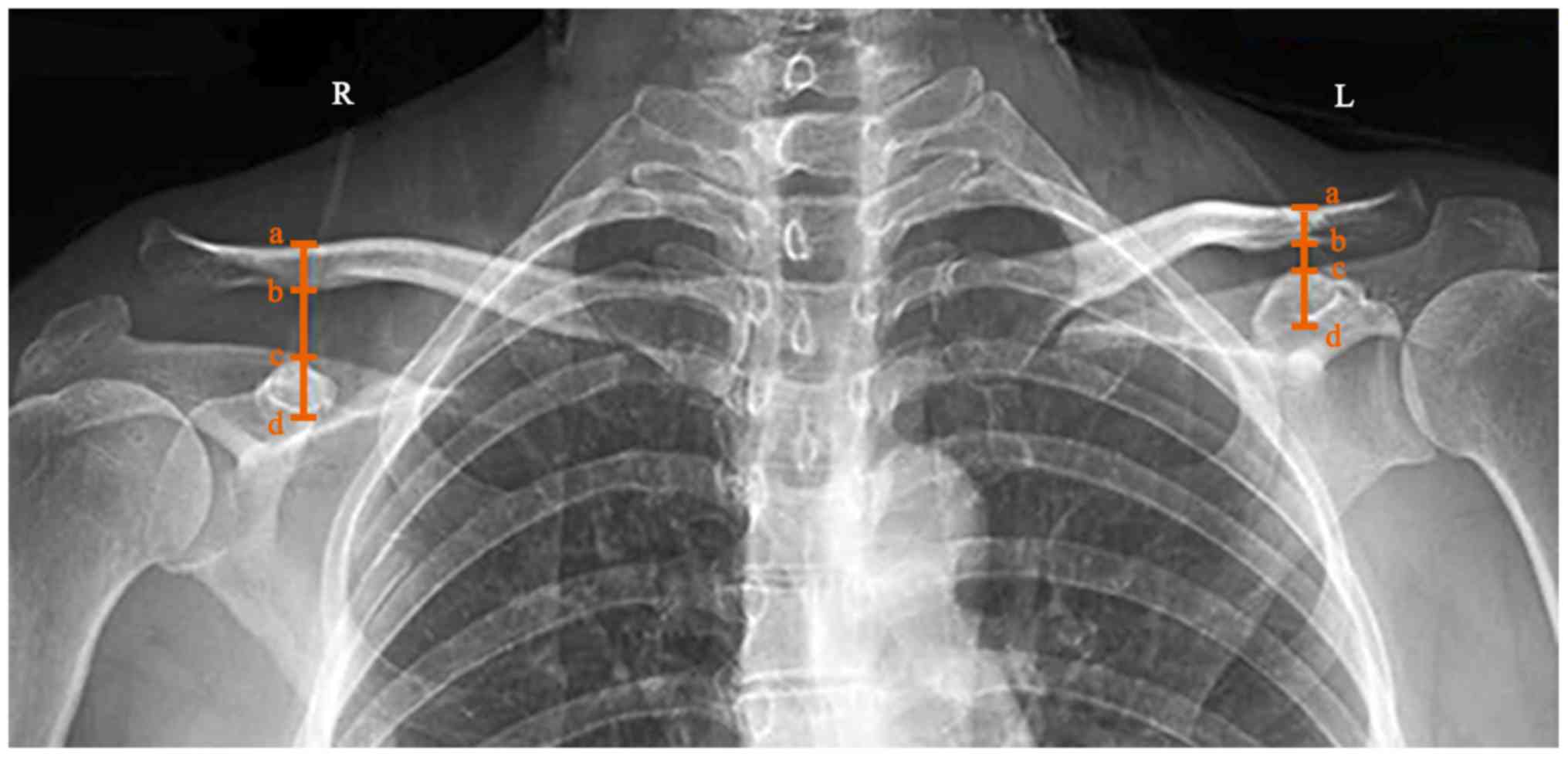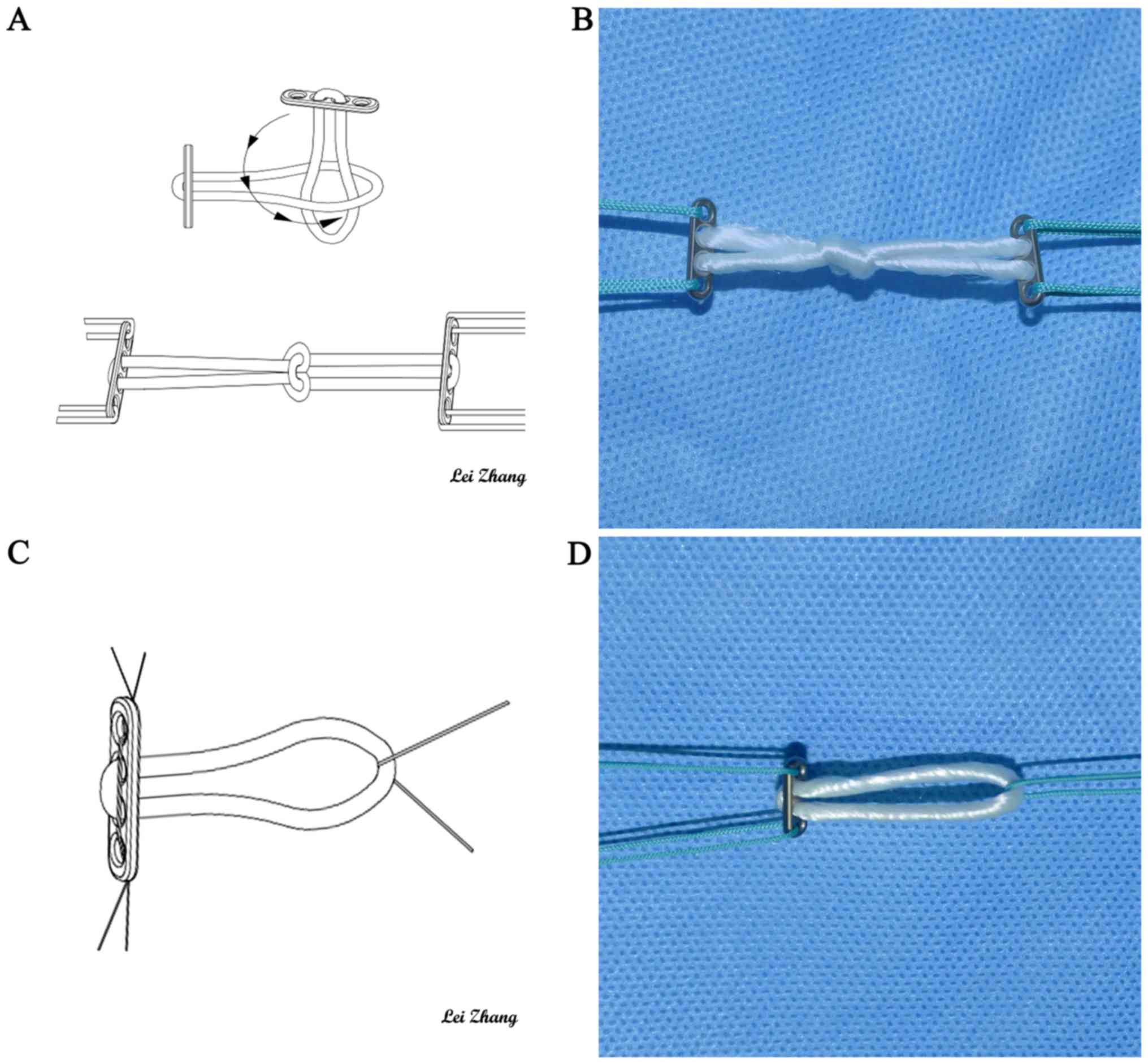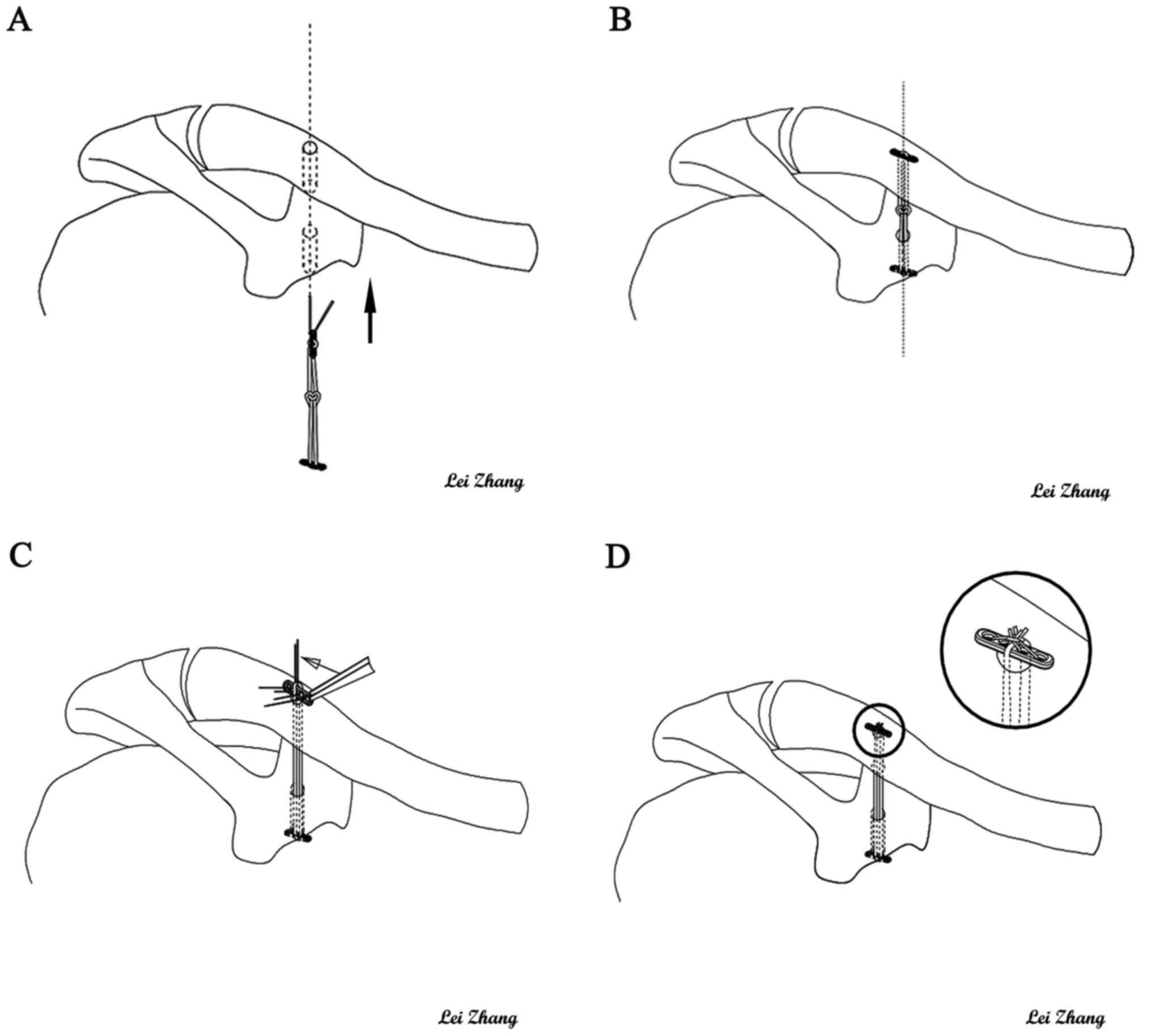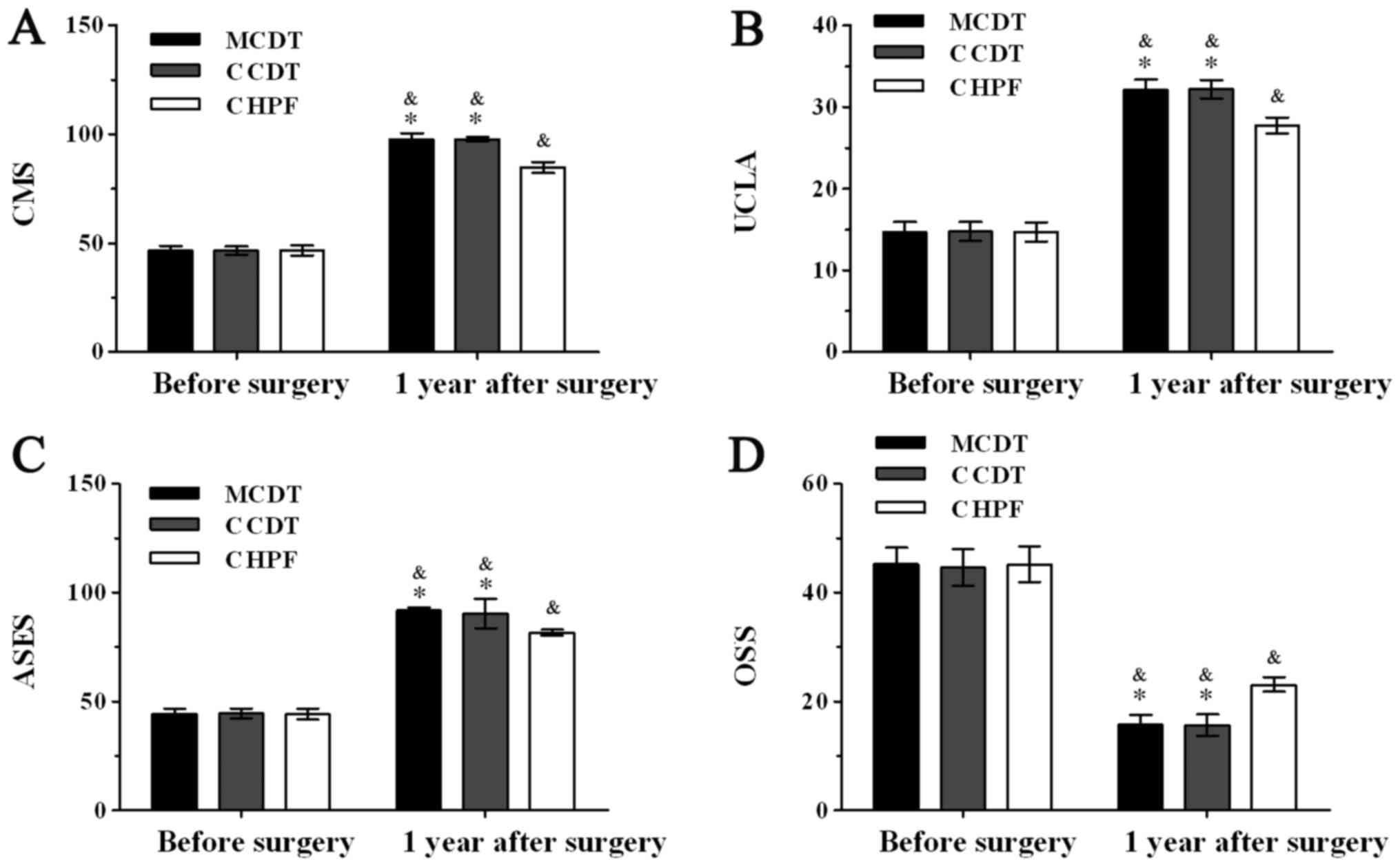|
1
|
Kim AC, Matcuk G, Patel D, Itamura J,
Forrester D, White E and Gottsegen CJ: Acromioclavicular joint
injuries and reconstructions: A review of expected imaging findings
and potential complications. Emerg Radiol. 19:399–413. 2012.
View Article : Google Scholar : PubMed/NCBI
|
|
2
|
Gstettner C, Tauber M, Hitzl W and Resch
H: Rockwood type III acromioclavicular dislocation: Surgical versus
conservative treatment. J Shoulder Elbow Surg. 17:220–225. 2008.
View Article : Google Scholar : PubMed/NCBI
|
|
3
|
Tauber M: Management of acute
acromioclavicular joint dislocations: Current concepts. Arch Orthop
Trauma Surg. 133:985–995. 2013. View Article : Google Scholar : PubMed/NCBI
|
|
4
|
Tossy JD, Mead NC and Sigmond HM:
Acromioclavicular separations: Useful and practical classification
for treatment. Clin Orthop Relat Res. 28:111–119. 1963.PubMed/NCBI
|
|
5
|
Rockwood CJ, Williams G and Young D:
Disorders of the acromioclavicular jointThe Shoulder. 2nd. Rockwood
CJ and Matsen FA III: Philadelphia: WB Saunders; pp. 483–553.
1998
|
|
6
|
Guy DK, Wirth MA, Griffin JL and Rockwood
CA Jr: Reconstruction of chronic and complete dislocations of the
acromioclavicular joint. Clin Orthop Relat Res. 1–149.
1998.PubMed/NCBI
|
|
7
|
Pallis M, Cameron KL, Svoboda SJ and Owens
BD: Epidemiology of acromioclavicular joint injury in young
athletes. Am J Sports Med. 40:2072–2077. 2012. View Article : Google Scholar : PubMed/NCBI
|
|
8
|
Kongmalai P, Apivatgaroon A and
Chernchujit B: Morphological classification of acromial spur:
Correlation between Rockwood tilt view and arthroscopic finding.
SICOT J. 3:42017. View Article : Google Scholar : PubMed/NCBI
|
|
9
|
McNeil JW, Beaulieu-Jones BR, Bernhardson
AS, LeClere LE, Dewing CB, Lynch JR, Golijanin P, Sanchez G and
Provencher MT: Classification and analysis of attritional glenoid
bone loss in recurrent anterior shoulder instability. Am J Sports
Med. 45:767–774. 2017. View Article : Google Scholar : PubMed/NCBI
|
|
10
|
Gorbaty JD, Hsu JE and Gee AO:
Classifications in brief: Rockwood classification of
acromioclavicular joint separations. Clin Orthop Relat Res.
475:283–287. 2017. View Article : Google Scholar : PubMed/NCBI
|
|
11
|
von Heideken J, Bostrȍm Windhamre H,
Une-Larsson V and Ekelund A: Acute Surgical treatment of
acromioclavicular dislocation type V with a hook plate: Superiority
to late reconstruction. J Shoulder Elbow Surg. 22:9–17. 2013.
View Article : Google Scholar : PubMed/NCBI
|
|
12
|
Wellmann M, da Silva G, Lichtenberg S,
Magosch P and Habermeyer P: Instability pattern of
acromioclavicular joint dislocations type Rockwood III: Relevance
of horizontal instability. Orthopade. 42:271–277. 2013.(In German).
View Article : Google Scholar : PubMed/NCBI
|
|
13
|
Kezunović M, Bjelica D and Popović S:
Comparative study of surgical treatment of acromioclavicular
luxation. Vojnosanit Pregl. 70:292–297. 2013. View Article : Google Scholar : PubMed/NCBI
|
|
14
|
Virtanen KJ, Remes VM, Tulikoura IT,
Pajarinen JT, Savolainen VT, Björkenheim JM and Paavola MP:
Surgical treatment of Rockwood grade-V acromioclavicular joint
dislocations: 50 patients followed for 15–22 years. Acta Orthop.
84:191–195. 2013. View Article : Google Scholar : PubMed/NCBI
|
|
15
|
Kienast B, Thietje R, Queitsch C, Gille J,
Schulz AP and Meiners J: Mid-term results after operative treatment
of Rockwood grade III–V Acromioclavicular joint dislocations with
an AC-hook-plate. Eur J MedRes. 16:52–56. 2011.
|
|
16
|
Kovilazhikathu Sugathan H and Dodenhoff
RM: Management of type 3 acromioclavicular joint dislocation:
Comparison long-term functional results of two operative methods.
ISRN Surg. 2012:5805042012.PubMed/NCBI
|
|
17
|
Gille J, Heinrichs G, Unger A, Riepenhof
H, Herzog J, Kienast B and Oheim R: Arthroscopic-assisted hook
plate fixation for acromioclavicular joint dislocation. Int Orthop.
37:377–382. 2013. View Article : Google Scholar
|
|
18
|
Struhl S: Double endobutton technique for
repair of complete acromioclavicular joint dislocations. Tech
Shoulder Elbow Surg. 8:175–179. 2007. View Article : Google Scholar
|
|
19
|
Di Francesco A, Zoccali C, Colafarina O,
Pizzoferrato R and Flamini S: The use of hook plate in type III and
V acromio-clavicular Rockwood dislocations: Clinical and
radiological midterm results and MRI evaluation in 42 patients.
Injury. 43:147–152. 2012. View Article : Google Scholar : PubMed/NCBI
|
|
20
|
Sandmann GH, Martetschläger F, Mey L,
Kraus TM, Buchholz A, Ahrens P, Stöckle U, Freude T and Siebenlist
S: Reconstruction of displaced acromio-clavicular joint
dislocations using a triple suture-cerclage: Description of a safe
and efficient surgical technique. Patient Saf Surg. 6:252012.
View Article : Google Scholar : PubMed/NCBI
|
|
21
|
Ranne JO, Sarimo JJ, Rawlins MI, Heinonen
OJ and Orava SY: All-arthroscopic double-bundle coracoclavicular
ligament reconstruction using autogenous semitendinosus graft: A
new technique. Arthrosc Tech. 1:e11–e14. 2012. View Article : Google Scholar : PubMed/NCBI
|
|
22
|
Choi NH, Lim SM, Lee SY and Lim TK: Loss
of reduction and complications of coracoclavicular ligament
reconstruction with autogenous tendon graft in acute
acromioclavicular dislocations. J Shoulder Elbow Surg. 26:692–698.
2017. View Article : Google Scholar : PubMed/NCBI
|
|
23
|
Clavert P, Meyer A, Boyer P, Gastaud O,
Barth J and Duparc F: SFA: Complication rates and types of failure
after arthroscopic acute acromioclavicular dislocation fixation.
Prospective multicenter study of 116 cases. Orthop Traumatol Surg
Res. 101 8 Suppl:S313–S316. 2015. View Article : Google Scholar : PubMed/NCBI
|
|
24
|
Helfen T, Siebenbürger G, Ockert B and
Haasters F: Therapy of acute acromioclavicular joint instability.
Meta-analysis of arthroscopic/minimally invasive versus open
procedures. Unfallchirurg. 118:415–426. 2015.(In German).
|
|
25
|
Longo UG, Ciuffreda M, Rizzello G,
Mannering N, Maffulli N and Denaro V: Surgical versus conservative
management of Type III acromioclavicular dislocation: A systematic
review. Br Med Bull. 122:31–49. 2017. View Article : Google Scholar : PubMed/NCBI
|
|
26
|
Zumstein MA, Schiessl P, Ambuehl B,
Bolliger L, Weihs J, Maurer MH, Moor BK, Schaer M and Raniga S: New
quantitative radiographic parameters for vertical and horizontal
instability in acromioclavicular joint dislocations. Knee Surg
Sports Traumatol Arthrosc. May 25–2017.(Epub ahead of print).
View Article : Google Scholar : PubMed/NCBI
|
|
27
|
Porschke F, Schnetzke M, Aytac S,
Studier-Fischer S, Gruetzner PA and Guehring T: Sports activity
after anatomic acromioclavicular joint stabilisation with
flip-button technique. Knee Surg Sports Traumatol Arthrosc.
25:1995–2003. 2017. View Article : Google Scholar : PubMed/NCBI
|
|
28
|
Faggiani M, Vasario GP, Mattei L, Calò MJ
and Castoldi F: Comparing mini-open and arthroscopic
acromioclavicular joint repair: Functional results and return to
sport. Musculoskelet Surg. 100:187–191. 2016. View Article : Google Scholar : PubMed/NCBI
|
|
29
|
Biz C, Berizzi A, Cappellari A, Crimì A,
Tamburin S and Iacobellis C: The treatment of acute Rockwood type
III acromio-clavicular joint dislocations by two different surgical
techniques. Acta Biomed. 86:251–259. 2015.PubMed/NCBI
|
|
30
|
Struhl S and Wolfson TS: Closed-loop
double endobutton technique for repair of unstable distal clavicle
fractures. Orthop J Sports Med. 4:23259671166578102016. View Article : Google Scholar : PubMed/NCBI
|
|
31
|
Ye G, Peng CA, Sun HB, Xiao J and Zhu K:
Treatment of Rockwood type III acromioclavicular joint dislocation
usingautogenous semitendinosus tendon graft and endobutton
technique. Ther Clin Risk Manag. 12:47–51. 2016. View Article : Google Scholar : PubMed/NCBI
|
|
32
|
Horst K, Garving C, Thometzki T, Lichte P,
Knobe M, Dienstknecht T, Hofman M and Pape HC: Comparative study on
the treatment of Rockwood type III acuteacromioclavicular
dislocation: Clinical results from the TightRope®
technique vs. K-wire fixation. Orthop Traumatol Surg Res.
103:171–176. 2017. View Article : Google Scholar : PubMed/NCBI
|
|
33
|
Thomas K, Litsky A, Jones G and Bishop JY:
Biomechanical comparison of coracoclavicular reconstructive
techniques. Am J Sports Med. 39:804–810. 2011. View Article : Google Scholar : PubMed/NCBI
|
|
34
|
Groh GI, Mighell MA, Basamania CJ and
Kibler WB: All things clavicle: From acromioclavicular to
sternoclavicular and all points in between. Instr Course Lect.
65:181–196. 2016.PubMed/NCBI
|
|
35
|
Grantham C, Heckmann N, Wang L, Tibone JE,
Struhl S and Lee TQ: A biomechanical assessment of a novel double
endobutton technique versus a coracoid cerclage sling for
acromioclavicular and coracoclavicular injuries. Knee Surg Sports
Traumatol Arthrosc. 24:1918–1924. 2016. View Article : Google Scholar : PubMed/NCBI
|
|
36
|
Kumar N and Sharma V: Hook plate fixation
for acute acromioclavicular dislocations without coracoclavicular
ligament reconstruction: A functional outcome study in military
personnel. Strategies Trauma Limb Reconstr. 10:79–85. 2015.
View Article : Google Scholar : PubMed/NCBI
|
|
37
|
Lu D, Wang T, Chen H and Sun LJ: A
comparison of double Endobutton and triple Endobutton techniques
for acute acromioclavicular joint dislocation. Orthop Traumatol
Surg Res. 102:891–895. 2016. View Article : Google Scholar : PubMed/NCBI
|
|
38
|
Hu WY, Yu C, Huang ZM and Han L: Double
Endobutton reconstituting coracoclavicular ligament combined with
repairing acromioclavicular ligament at stage I for the treatment
of acromioclavicular dislocation with Rockwood type III–V. Zhongguo
Gu Shang. 28:500–503. 2015.(In Chinese). PubMed/NCBI
|
|
39
|
Struhl S, Wolfson TS and Kummer F:
Axial-plane biomechanical evaluation of 2 suspensory cortical
button fixation constructs for acromioclavicular joint
reconstruction: Orthop. J Sports Med. 16:23259671166746682016.
|
|
40
|
Struhl S and Wolfson TS: Continuous loop
double endobutton reconstruction for acromioclavicular joint
dislocation. Am J Sports Med. 43:2437–2444. 2015. View Article : Google Scholar : PubMed/NCBI
|
|
41
|
Beris A, Lykissas M, Kostas-Agnantis I,
Vekris M, Mitsionis G and Korompilias A: Management of acute
acromioclavicular joint dislocation with a double-button fixation
system. Injury. 44:288–292. 2013. View Article : Google Scholar : PubMed/NCBI
|
|
42
|
Li H, Wang C, Wang J, Wu K and Hang D:
Restoration of horizontal stability in complete acromioclavicular
joint separations: Surgical technique and preliminary results. Eur
J Med Res. 18:422013. View Article : Google Scholar : PubMed/NCBI
|
|
43
|
Constant CR and Murley AH: A clinical
method of functional assessment of the shoulder. Clin Orthop Relat
Res. 1–164. 1987.
|
|
44
|
Amstutz HC, Sew Hoy AL and Clarke IC: UCLA
anatomic total shoulder arthroplasty. Clin Orthop Relat Res. 1–20.
1981.
|
|
45
|
Richards RR, An KN, Bigliani LU, Friedman
RJ, Gartsman GM, Gristina AG, Iannotti JP, Mow VC, Sidles JA and
Zuckerman JD: A standardized method for the assessment of shoulder
function. J Shoulder Elbow Surg. 3:347–352. 1994. View Article : Google Scholar : PubMed/NCBI
|
|
46
|
Dawson J, Fitzpatrick R and Carr A: The
assessment of shoulder instability: The development and validation
of a questionnaire. J Bone Joint surg Br. 81:420–426. 1999.
View Article : Google Scholar : PubMed/NCBI
|
|
47
|
Beitzel K, Cote MP, Apostolakos J,
Solovyova O, Judson CH, Ziegler CG, Edgar CM, Imhoff AB, Arciero RA
and Mazzocca AD: Current concepts in the treatment of
acromioclavicular joint dislocations. Arthroscopy. 29:387–397.
2013. View Article : Google Scholar : PubMed/NCBI
|
|
48
|
Takase K and Yamamoto K: Changes in
surgical procedures for acromioclavicular joint dislocation over
the past 30 years. Orthopedics. 36:e1277–e1282. 2013. View Article : Google Scholar : PubMed/NCBI
|
|
49
|
Arirachakaran A, Boonard M, Piyapittayanun
P, Kanchanatawan W, Chaijenkij K, Prommahachai A and
Kongtharvonskul J: Post-operative outcomes and complications of
suspensory loop fixation device versus hook plate in acute unstable
acromioclavicular joint dislocation: A systematic review and
meta-analysis. J Orthop Traumatol. Feb 25–2017.(Epub ahead of
print). View Article : Google Scholar : PubMed/NCBI
|
|
50
|
Murena L, Vulcano E, Ratti C, Cecconello
L, Rolla PR and Surace MF: Arthroscopic treatment of acute
acromioclavicular joint dislocation with double flip button. Knee
Surg Sports Traumatol Arthrosc. 17:1511–1515. 2009. View Article : Google Scholar : PubMed/NCBI
|
|
51
|
Korsten K, Gunning AC and Leenen LP:
Operative or conservative treatment in patients with Rockwood type
III acromioclavicular dislocation: A systematic review and update
of current literature. Int Orthop. 38:831–838. 2014. View Article : Google Scholar : PubMed/NCBI
|
|
52
|
Balke M, Schneider MM, Akoto R, Bähis H,
Bouillon B and Banerjee M: Acute acromioclavicular joint injuries:
Changes in diagnosis and therapy over the last 10 years.
Unfallchirurg. 118:851–857. 2014. View Article : Google Scholar
|
|
53
|
González-Erreguín V and Morales-Villanueva
J: Surgical treatment of acute acromioclavicular dislocation
Preliminary report. Acta Ortop Mex. 29:203–206. 2015.(In Spanish).
PubMed/NCBI
|
|
54
|
Ejam S, Lind T and Falkenberg B: Surgical
treatment of acute and chronic acromioclavicular dislocation Tossy
type III and V using the Hookplate. Acta Orthop Belg. 74:441–445.
2008.PubMed/NCBI
|
|
55
|
Nühtern JV, Sellenschloh K, Bishop N,
Jauch S, Briem D, Hoffmann M, Lehmann W, Pueschel K, Morlock MM,
Rueger JM and Großterlinden LG: Biomechanical evaluation of 3
stabilization methods on acromioclavicular joint dislocations. Am J
Sports Med. 41:1387–1394. 2013. View Article : Google Scholar : PubMed/NCBI
|
|
56
|
McKee MD: Operative fixation of chronic
acromioclavicular joint dislocation with hook plate and modified
ligament transfer. J Orthop Trauma. 30 Suppl 2:S7–S8. 2016.
View Article : Google Scholar : PubMed/NCBI
|
|
57
|
Lee CH, Shih CM, Huang KC, Chen KH, Hung
LK and Su KC: Biomechanical analysis of implanted clavicle hook
plates with different implant depths and materials in the
acromioclavicular joint: A finite element analysis study. Artif
Organs. 40:1062–1070. 2016. View Article : Google Scholar : PubMed/NCBI
|
|
58
|
Lin HY, Wong PK, Ho WP, Chuang TY, Liao YS
and Wong CC: Clavicular hook plate may induce subacromial shoulder
impingement and rotator cuff lesion-dynamic sonographic evaluation.
J Orthop Surg Res. 9:62014. View Article : Google Scholar : PubMed/NCBI
|
|
59
|
Sun S, Gan M, Sun H, Wu G, Yang H and Zhou
F: Does subacromial osteolysis affect shoulder function after
clavicle hook plating? Biomed Res Int. 2016:40853052016. View Article : Google Scholar : PubMed/NCBI
|
|
60
|
Shih CM, Huang KC, Pan CC, Lee CH and Su
KC: Biomechanical analysis of acromioclavicular joint dislocation
treated with clavicle hook plates in different lengths. Int Orthop.
39:2239–2244. 2015. View Article : Google Scholar : PubMed/NCBI
|
|
61
|
Coale RM, Hollister SJ, Dines JS, Allen AA
and Bedi A: Anatomic considerations of
transclavicular-transcoracoid drilling for coracoclavicular
ligament reconstruction. J Shoulder Surg. 22:137–144. 2013.
View Article : Google Scholar
|
|
62
|
Chaudry SN and Waseem M: Clavicular hook
plate: Complications of retaining the implant. Injury. 37:6652006.
View Article : Google Scholar : PubMed/NCBI
|
|
63
|
Steinbacher G, Sallent A, Seijas R, Boffa
JM, Espinosa W and Cugat R: Clavicular hook plate for grade-III
acromioclavicular dislocation. J Orthop Surg (Hong Kong).
22:329–332. 2014. View Article : Google Scholar : PubMed/NCBI
|
|
64
|
Jafary D, Keihan Shokouh H, Najd Mazhar F,
Shariat Zadeh H and Mochtary T: Clinical and radiological results
of fixation of acromioclavicular joint dislocation by hook plates
retained for more than five months. Trauma Mon. 19:e137282014.
View Article : Google Scholar : PubMed/NCBI
|
















